
It’s a balmy morning in Tennessee. You drink your morning coffee admiring the first sunbeams as they hit your green lawn and notice a distinct clump that isn’t supposed to be there. From dandelion and plantain to crabgrass and dallisgrass, we have 17 common weeds in Tennessee lawns and how you can identify and control them.
Tennessee is known for its lush green landscapes, but with that beauty comes the challenge of dealing with common lawn weeds. Identifying these pesky plants is the first step in effectively controlling them and maintaining a healthy lawn. By learning about the different types of weeds that thrive in Tennessee’s climate, you can implement targeted strategies to keep your lawn looking its best.
Sedges
Yellow Nutsedge (Cyperus esculentus)
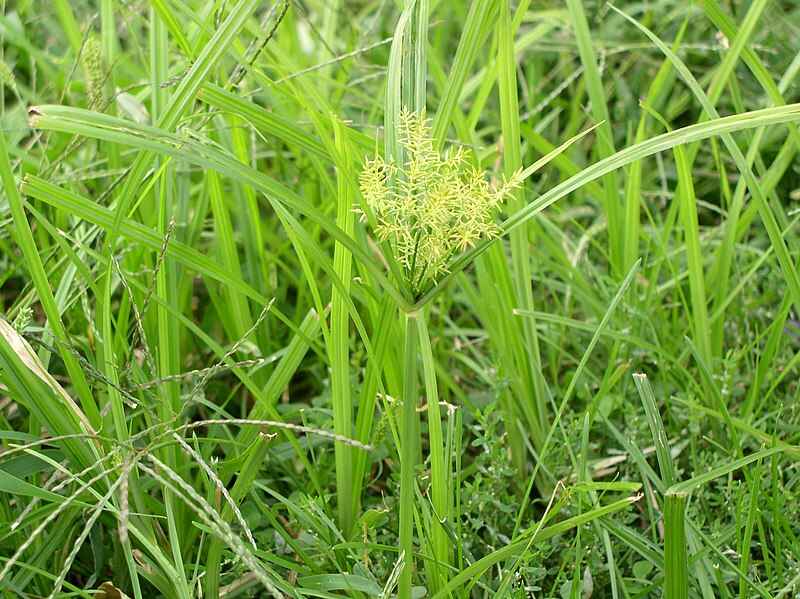
A common turfgrass weed, yellow nutsedge is prevalent in east Tennessee, while purple nutsedge (Cyperus rotundus) is more common in the western part of the state. Yellow nutsedge differs from purple nutsedge only in its color and cold tolerance. Emerging in late spring, these weeds grow from rhizomes and underground tubers and spread in excessively wet turfgrasses during summer.
- Life cycle: Perennial
- Weed type: Sedge
- Where it thrives: Yellow nutsedge grows best in wet areas with full sun exposure but can adapt to various conditions. It often indicates excess watering or poor soil drainage.
- How to identify nutsedge: Look for long, light green, or yellow leaves with a glossy appearance. A triangular stem, typical of sedges, is a key feature to differentiate it from other grassy weeds. The flowers bloom at the end of the branches as yellow spikelets.
During summer, their vertical growth will be faster, so their leaves will stand out from the desired turfgrass’s height. - How to get rid of nutsedge: Nutsedge can be hand-pulled, but ensure you remove all underground tubers and rhizomes. To control nutsedge in your yard, use a post-emergent herbicide. Selective herbicides are only effective when applied on actively growing plants, so the ideal application time is from May to August.
The best way to control sedges is to resolve the underlying problem, such as drainage problems or excessive irrigation, that is encouraging it to grow. Applying soil amendments, such as compost, is a great way to solve drainage problems.
Green Kyllinga (Kyllinga brevifolia)

Green kyllinga is similar to yellow nutsedge both in growth habit and in appearance. Flowering during all warm months, its flowers can grow even with regular lawn mowing. This weed’s ability to resist low mowing heights comes from its low growth habit, spreading through short rhizomes that form dense mats in the turfgrass.
- Life cycle: Perennial
- Weed type: Sedge
- Where it thrives: Green kyllinga grows in warm soils that hold excessive moisture for extended periods and is usually an indicator of poor soil drainage and overwatering.
- How to identify kyllinga: The leaves of kyllinga have a waxy appearance and are usually shorter and have a finer leaf texture than other sedges. The stem has a triangular shape, as is characteristic of this weed type.
- How to get rid of kyllinga: Prevention is the best option for green kyllinga because it is harder to control than yellow nutsedge. Assess your lawn to resolve any possible drainage problems and cultivate a healthy, dense turf to outcompete this invasive species. Aerating your lawn can help with drainage issues.
To control active infestations with selective post-emergent herbicides, apply from May through August when the plant is still actively growing.
Grassy Weeds
Smooth Crabgrass (Digitaria ischaemum)
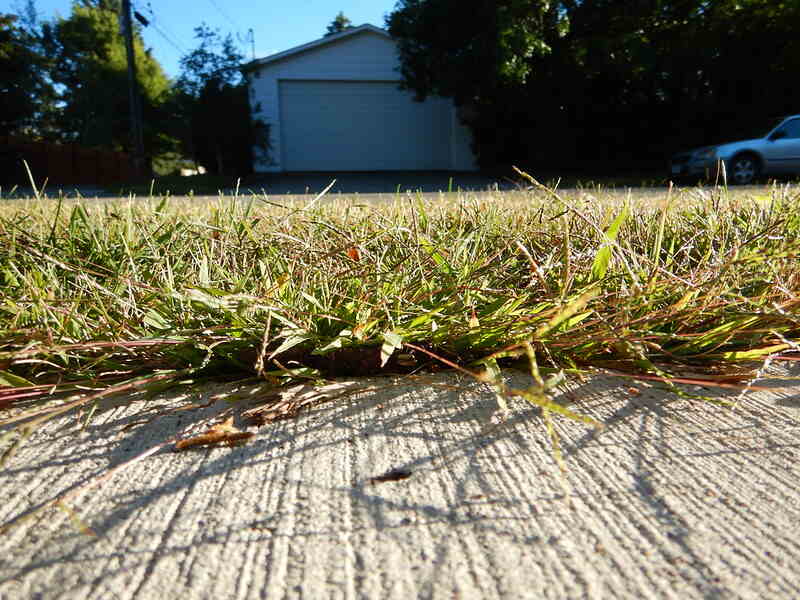
More prevalent in Tennessee lawns than large crabgrass (Digitaria sanguinalis), smooth crabgrass (Digitaria ischaemum) germinates in the spring, growing through summer and producing seed during fall to die in the first frost.
- Life cycle: Summer annual
- Weed type: Grassy
- Where it thrives: Crabgrass can grow in various sun conditions, from full sun to part shade, and prefers heavy soils. If you can read your weeds, you’ll know that crabgrass can indicate excessive nitrogen levels in the soil.
- How to identify crabgrass: Smooth crabgrass differentiates itself from large crabgrass mainly by its lack of hair covering the leaves. The leaves’ color is light green, and they grow from prominent nodes alternating in opposite directions.
- How to get rid of crabgrass: Crabgrass hugs the ground as it grows, making it hard to pull by hand once established. Testing your soil will let you know if you’re over-fertilizing your lawn with nitrogen, which can encourage crabgrass.
To get rid of crabgrass before it sprouts in your lawn, use a pre-emergent herbicide application in the spring, before the last forsythia flowers fall, as part of your spring lawn care in the Nashville area. If you live in west Tennessee, apply in late February or early March. If you live in the eastern part of the state, apply from mid-March to early April.
Pro tip: Post-emergent herbicides can be applied anytime after germination when the plant is still growing. Always check the label and see if the product is appropriate for your turf type. Many of the best post-emergent herbicides are targeted to work on specific plants but can seriously damage your turf if used incorrectly.
Dallisgrass (Paspalum dilatatum)
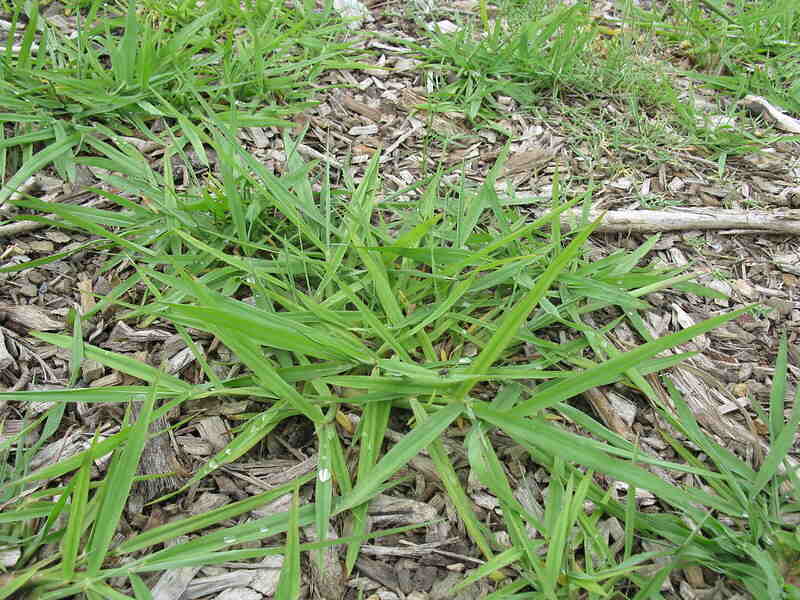
If you spot dallisgrass on your lawn, know there is hard work ahead. This weed is one of the most difficult to control in Tennessee, invading lawns statewide. This clumping perennial spreads through thick rhizomes and can create such damage that, in some cases, you may need to lay sod and do a complete lawn renovation.
- Life cycle: Perennial
- Weed type: Grassy
- Where it thrives: Dallisgrass can grow in full sun as well as partially shaded areas. It prefers wet soil conditions, such as flooded areas or overwatered lawns.
- How to identify dallisgrass: Dallisgrass has a distinct grayish-green color. The leaves have a mid-rib that also helps differentiate dallisgrass from other grassy, coarse-textured weeds. The seed heads are also characteristic and consist of hairy spikelets.
- How to get rid of dallisgrass: Apply a post-emergent herbicide to control active dallisgrass infestations in Bermudagrass or other warm-season grasses in the fall, when the turf is preparing for dormancy. The easier way is preventing dallisgrass from ever establishing by cultivating a strong, healthy lawn.
Goosegrass (Eleusine indica)

Goosegrass is rarely found in healthy lawns and can be a sign of compacted soil. Emerging in late summer, it grows close to the ground, which makes it resistant to mowing. It is a prolific seed producer, so controlling it as early as possible is crucial to prevent persistent infestations.
- Life cycle: Summer annual
- Weed type: Grassy
- Where it thrives: Goosegrass loves compacted soils with poor drainage.
- How to identify goosegrass: Goosegrass grows in clumps from a central taproot with a fibrous root system. A tell-tale sign is a white color that the leaves present at the base. The leaves have a smooth texture.
- How to get rid of goosegrass: You can prevent goosegrass by controlling the traffic on your lawn and making sure the grass is growing strong and healthy so it outcompetes goosegrass. Core aeration will also help with soil compaction problems, preventing favorable conditions for the weed to establish itself.
If you’re dealing with a small infestation, hand-pulling can be effective. For larger infestations, apply post-emergence herbicides anytime from May to early August. More than one application might be necessary to control the weed.
Pro tip: To prevent seedlings from sprouting, apply pre-emergent herbicides from February to early March as part of your spring lawn care in western Tennessee. If you’re in eastern Tennessee, apply in mid-March to early April. Perform a second application six to eight weeks later.
Annual Bluegrass (Poa annua)

Annual bluegrass is a winter annual that commonly invades Bermudagrass lawns. When Bermudagrass enters its dormancy period, it is the perfect opportunity for this competitive weed to take over. Controlling annual bluegrass is essential since it produces abundant seeds that can remain dormant, forming seedbanks in the soil that can compromise your turfgrass for many years.
- Life cycle: Winter annual
- Weed type: Grassy
- Where it thrives: Annual bluegrass prefers shaded areas with moist soil.
- How to identify annual bluegrass: The leaves have a greenish-yellow color. Annual bluegrass forms patches or clumps, making it easy to identify amongst the turf.
- How to get rid of annual bluegrass: Using different control methods is essential when dealing with this weed because it has shown signs of herbicide resistance. If dealing with small plants, you can remove them manually. Overseeding your lawn with cool-season grasses during fall can also help with infestations.
Using pre-emergent herbicides is not recommended if you plan to overseed your lawn in the fall. For non-overseeded lawns, apply pre-emergent herbicides in late August as part of your fall lawn care checklist since annual bluegrass starts to germinate in September. If the weed has already sprouted in your lawn, apply a post-emergent herbicide.
Johnsongrass (Sorghum halepense)

If johnsongrass creeps into your lawn, it can cause a lot of trouble. Spreading via thick rhizomes, it is a prolific seed producer and is poisonous to humans if eaten. This warm-season perennial is actually native to the Mediterranean region and was brought to the U.S. as a forage crop.
- Life cycle: Perennial
- Weed type: Grass
- Where it thrives: Johnsongrass can grow in different soil conditions but thrives under full sun and in fertile soils.
- How to identify johnsongrass: Coarse rhizomes and narrow leaves can differentiate johnsongrass from shattercane (Sorghum bicolor). Smooth leaves with a vein in their center. Stems that are pink to reddish near the base.
- How to get rid of johnsongrass: This weed is more common in agricultural fields than home lawns. But if you come across johnsongrass in your turf, hand-pulling works for small infestations.
Larger infestations will demand combined methods: mowing and repeated post-emergent herbicide applications. Remember: The best weed control is maintaining a healthy and dense lawn.
Green Foxtail (Setaria viridis)

This summer annual grass grows tall, making it easy to spot. Green foxtail inflorescences can grow up to 4 inches tall, and the leaves can reach 12 inches long. It spreads aggressively, producing many generations during the same season.
- Life cycle: Summer annual
- Weed type: Grassy
- Where it thrives: Green foxtail thrives in moist, high-fertility soils. Can grow in full sun or partial shade.
- How to identify foxtail: The characteristic mature seed head is a green tapered cylinder covered with barbs. The leaves are long and grow erect instead of lying down.
- How to get rid of foxtail: Mowing before seed production is an effective way of controlling foxtail. Repeated post-emergent herbicide applications will get rid of the already existing invasive plants, and you can always combine both methods to ensure effective foxtail control.
Broadleaf Weeds
Wild Violet (Viola spp.)
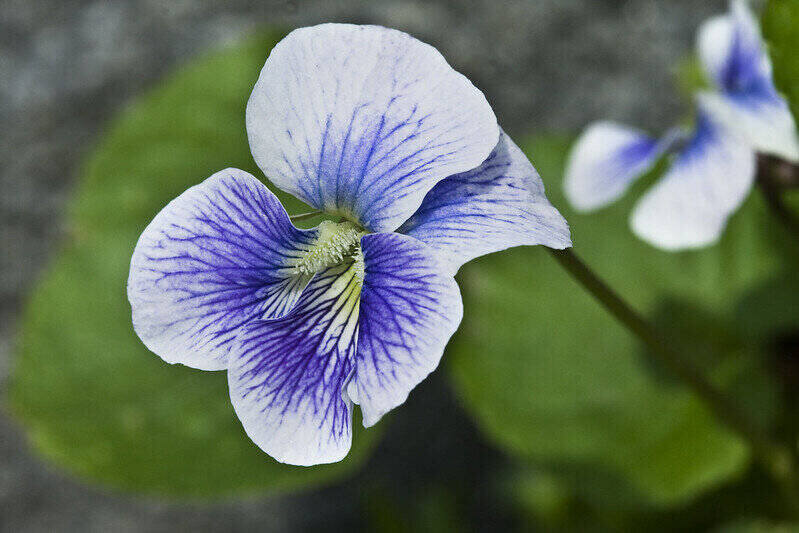
The weed is in the eye of the beholder, or so they say. While wild violet is an edible flower for your garden, once it spreads in your turfgrass, it can turn into a troublesome weed. Wild violet is a commonly used name to refer to various species of the same genus (Viola spp.), and it is known to be one of the most difficult-to-control perennial broadleaf weeds.
- Life cycle: Perennial
- Weed type: Broadleaf
- Where it thrives: Wild violets thrive in shaded sites with moist and fertile soil.
- How to identify wild violet: Wild violet is a low-grower with heart-shaped leaves. Different species can produce different colored flowers (blue, violet, purple, or white).
- How to get rid of wild violet: Healthy turfgrass usually discourages wild violet growth. There are no pre-emergent herbicides labeled for wild violet, so investing in cultural practices such as frequent mowing, regular fertilization, and good sun exposure will place the odds on your side.
If dealing with an active infestation, you can combine removing the weeds manually (with a weed-pulling tool or a shovel) and multiple applications of post-emergent herbicides. Autumn is the best time to treat wild violet and other perennial weeds in Tennessee.
Dandelion (Taraxacum officinale)

Dandelion or lion’s tooth is a fast-spreading perennial that, once established, is hard to eliminate. Its taproot can grow 10 inches deep into the soil and regenerate new plants. Mow these weeds down before they form their characteristic fluffy seed heads. While blowing its puffballs can grant you a wish, it can also grant you a huge infestation.
- Life cycle: Winter perennial
- Weed type: Broadleaf
- Where it thrives: Dandelions might be a sign of acidic soil conditions. They can grow in a variety of soils with full sun exposure, but they thrive in soils with low calcium and high nitrogen and potassium levels.
- How to identify dandelion: Dandelion is easily identified by its puffballs, which are actually the plant’s seed head. It also blooms in bright yellow flowers in spring. Its leaves are long, with serrated edges.
How to get rid of dandelion: Since dandelions can regenerate if severed from the taproot, you’ll have to completely remove it. Another natural way of controlling dandelions is improving your lawn by applying mulch, which can block the plant’s access to sunlight.
You can also combine these practices with herbicide treatments to get rid of dandelions. Apply a broadleaf post-emergent herbicide during fall, which is generally more effective on perennials. If it’s already spring, apply a pre-emergent herbicide to prevent the seeds from sprouting in your lawn.
Broadleaf Plantain (Plantago major)

If you have a broadleaf plantain infestation, you will know it: This weed’s upward-pointing stems can reach 12 inches tall and are easily spotted anywhere. Broadleaf plantain can indicate damp and compacted soil.
- Life cycle: Perennial
- Weed type: Broadleaf
- Where it thrives: Plantain has great adaptability to most soils, wet or dry, and thrives in compacted or disturbed soils. It can grow in full sun or partial shade.
- How to identify plantain: The leaves rest flat on the ground and have wavy edges. They also present prominent veins and are covered in short hairs that make them harsh to the touch. Flowering stems grow erect with no branches.
- How to get rid of plantain: Broadleaf plantain has a short taproot that makes it easy to hand pull. You can also spot-treat them by applying post-emergent herbicides. Maintaining healthy lawn conditions can also help prevent the weed from establishing: mow at the right height, aerate, and avoid excess watering.
Common Chickweed (Stellaria media)

Chickweed is a persistent winter annual that spreads through self-seeding. The seeds germinate in late summer and early fall. The plant grows during winter when warm-season turfgrasses are dormant and cannot outcompete the weed.
- Life cycle: Winter annual
- Weed type: Broadleaf
- Where it thrives: Common chickweed can indicate poorly-drained soil. It often grows in wet turf under shady areas.
- How to identify chickweed: Chickweed has a slim stem and a characteristic row of fine hair that grows on one side. The leaves are egg-shaped and grow in opposite directions. Small white flowers bloom in clusters.
- How to get rid of chickweed: The shallow root system makes it easy to manually remove this weed. You can also use a trowel as an aid to dig up the roots. Proper cultural practices that increase turfgrass density, such as regular lawn fertilization, will prevent weeds from invading.
You can also control chickweed with pre-emergent herbicide applications in late summer. Post-emergent herbicides can easily control chickweed when applied while the weeds are still young, during fall and early spring. Also, improving the drainage in your yard can deter chickweed from growing.
Henbit (Lamium amplexicaule)

A prevalent winter annual weed, henbit germinates in the fall. In spring it flowers and seeds then shrivels in the summer heat. Its ability to grow in a variety of environments and quick life cycle make it a common nuisance in many Tennessee lawns.
- Life cycle: Winter annual
- Weed type: Broadleaf
- Where it thrives: Henbit can grow in sandy soil, but thrives in rich, fertile soil and shady areas.
- How to identify henbit: Henbit has square stems that can sometimes be purplish. The leaves are hairy and have a kidney shape with serrated edges.
- How to get rid of henbit: Henbit seedlings can be controlled with a pre-emergent herbicide application in late summer. If the weeds have already sprouted, post-emergent broadleaf herbicides can be applied in the early growth stages. Cultural practices to improve turfgrass density, such as overseeding, can also prevent henbit from growing on your lawn.
Ragweed (Ambrosia artemisiifolia)

This member of the daisy family is native to North America and grows countrywide. Very drought-tolerant, ragweed seeds can be viable for years to come. When in direct contact with the skin, ragweed can cause dermatitis and other allergic reactions.
- Life cycle: Summer annual
- Weed type: Broadleaf
- Where it thrives: Ragweed likes poor soils and full sun exposure.
- How to identify ragweed: Ragweed has hairy and branched stems that can grow to reach up to 6 feet tall. The leaves are compound and deeply lobed, growing in opposite directions.
- How to get rid of ragweed: Ragweed can be prevented with regular applications of the right fertilizer and other measures to ensure lawn health. Pre-emergent or post-emergent herbicides that effectively control ragweed are also available on the market.
Yellow Wood Sorrel (Oxalis stricta)
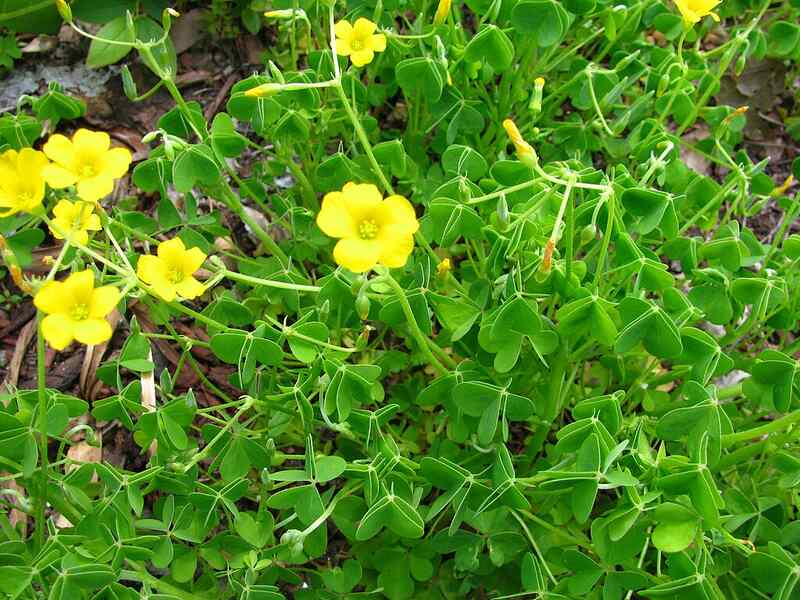
Yellow wood sorrel is a perennial broadleaf that spreads aggressively through rhizomes and stolons. Additionally, it also produces and spreads through seeds, making it very hard to completely eradicate once established.
- Life cycle: Perennial
- Weed type: Broadleaf
- Where it thrives: Yellow wood sorrel thrives in alkaline soils with a sandy-loam texture and good drainage. It can grow in full sun or partial shade.
- How to identify wood sorrel: Yellow wood sorrel has small yellow flowers (hence the name). The stems have a pinkish color and grow pointing upwards. Each leaf has three heart-shaped leaflets, reminiscent of a clover leaf (check out this article on the differences between clover and oxalis). Curiously, the leaves curl up at night and open in the morning.
- How to get rid of wood sorrel: Wood sorrel is almost impossible to completely remove. Improve your lawn with mulch to block its access to sunlight and slow germination. This will not stop the roots from spreading, though. Pre-emergent herbicide applications can control this weed. When plants are young, non-selective herbicides work effectively.
Spotted Spurge (Euphorbia maculata)

This summer annual has a low growth habit, making it excellent at escaping mower blades. Spotted spurge grows during the warm months when its tiny flowers bloom. It spreads rapidly since it has a short to no seed dormancy at all.
- Life cycle: Summer annual
- Weed type: Broadleaf
- Where it thrives: Spotted spurge prefers full sun exposure. Grows in various soil types with good drainage.
- How to identify spotted spurge: This weed has a typical purple or brown spot in the center of each leaf. Milky sap is released from the stems when broken.
- How to get rid of spotted spurge: Because it grows from a single taproot, spotted spurge is easy to hand pull. The lack of seed dormancy makes it a fast-spreading weed, so applying pre-emergent herbicides is a good option for spotted spurge control. A lawn care tip for Tennessee homeowners battling spurge is to reduce its access to the lawn by improving turf density.
Spiny Sowthistle (Sonchus asper)

Spiny sowthistle or prickly sowthistle is an aggressive-growing wildflower. Once they start producing seeds, they can spread through wind or water and quickly take over your lawn. Mature plants can grow deep roots that are a handful to remove.
- Life cycle: Summer annual, occasionally biennial
- Weed type: Broadleaf
- Where it thrives: Spiny sowthistle loves full sun and can adapt to a range of soil types. Its presence can indicate a neglected lawn.
- How to identify spiny sowthistle: Yellow flower heads quickly appear in the summer. The leaves’ edges have characteristic spiny teeth.
- How to get rid of spiny sowthistle: For small infestations, hand-pulling can be done. Make sure you improve the soil quality so your turf can outcompete the weed. Spiny sowthistle is also controlled by post-emergent herbicide applications.
FAQ
What are the Most Common Types of Weeds in Tennessee Lawns?
Three main types of weeds commonly grow in Tennessee:
- Grasses: When germinating, they produce one single leaf (monocot). Grass leaves have a linear form.
- Broadleaves: They produce two leaves when germinating (dicots) and form leaves in a variety of shapes.
- Sedges: They are monocots like the grasses (produce one leaf), but they grow in groups of three and have a characteristic triangular stem.
What are the Life Cycles of Weeds?
Tennessee weeds have one of three life cycles:
- Summer annuals: These weeds germinate in spring, grow during summer, and produce seeds during fall. They can die in the fall or after the first hard frost.
- Winter annuals: Overlapping two calendar years, these plants germinate in late summer to early fall and go dormant or semi-dormant during winter. Flowering in the early spring, they mature and wither by the end of this season or in early summer.
- Perennials: Perennials live for more than two years and some can regenerate for seasons to come.
How Can I Prevent Weeds From Invading My Lawn?
The best way to prevent weeds is a good lawn care routine. Maintaining a dense, healthy turf is the best way to avoid the trouble of dealing with weed problems:
- Plant the right kind of grass for your area. Choosing the best grass seed for Tennessee lawns will create a healthy turf that will deter weeds. For more information, check out our article “When is the Best Time to Plant Grass Seed in Tennessee?”
- Mow at the right height and frequency for your turfgrass.
- Fertilize the soil according to its needs. Soil testing can help you understand what your soil is craving.
- Irrigate with the appropriate amounts of water for your turf species and seasonal conditions.
- Aerate and dethatch to help with soil drainage and prevent compaction.
- Overseed cool-season turfgrasses during fall so opportunistic winter annual weeds don’t take over (see our article: “Best Time to Aerate and Overseed a Lawn in Tennessee”).
Call a Lawn Care Pro
Identifying and controlling weeds can certainly be a handful. But we’re happy to offer a helping hand (or a weed-pulling hand, if you will). So if you’re looking for a Tennessee lawn care pro near you, we have trusted lawn care pros in Nashville, Memphis, Knoxville, Chattanooga, Franklin, and many more cities across the Volunteer State.
LawnStarter participates in the Amazon Services LLC Associates Program, an affiliate advertising program. LawnStarter may earn revenue from products promoted in this article.
Main Image Credit: tdlucas5000 / Flickr / CC BY 2.0